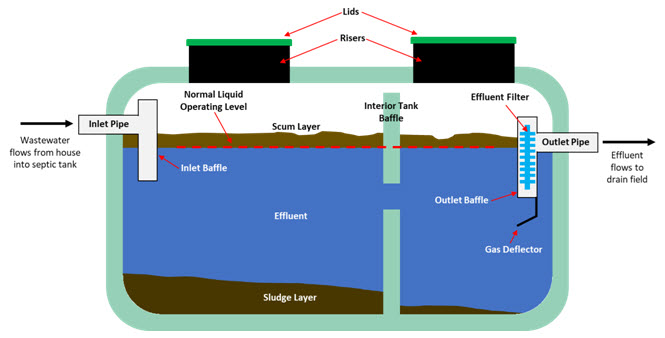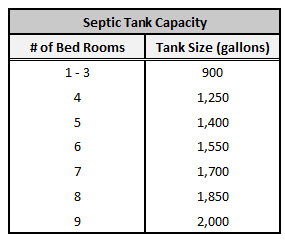What is a septic tank?
A septic tank is water-tight container usually made of concrete, fiberglass, or polyethylene (plastic). It is just one part of the septic system, which typically consist of a pipe from the home, a septic tank, and a drain field but may also include a distribution box, pumps, float switches, aerators, filters, and many other components. Many rural and suburban areas that don’t have centralized sewer systems rely on septic systems to treat their wastewater on site. If you have a septic system, you will likely find a septic tank buried in your yard. The diagram below shows the components of a typical septic tank.


There are 6 main components of a septic tank:
How does a septic tank work?
All the wastewater from your house flows into your septic tank through a main drainage pipe. The septic tank is simply a settling tank that acts as a filter to stop solids from entering your drain field. It is designed to keep water in the tank for at least one day to allow time for the solids to settle. During this time, two things happen: bacteria in the septic tank break down biodegradable solids, and the solids that can’t be broken down separate from the liquid. Heavy solids, such as dirt and digested waste, will sink to the bottom of the tank to form the sludge layer. Meanwhile, solids that are lighter than water, such as grease, hair, and toilet paper, will float to the top to form the scum layer. The liquid in between the sludge and scum layers is known as effluent. In a properly maintained septic tank, this effluent will be relatively clear and free of solids. It is important that solids have enough time and space to settle.
Therefore, you must have a septic tank that is big enough to handle the flow of wastewater from your house or business. In fact, the Pennsylvania DEP requires a minimum capacity of 900 gallons for any new septic tank installations (the table below shows recommended septic tank capacities for different sized homes).

For your septic tank to operate properly, you must also get it cleaned regularly so that it doesn’t fill with solids. The Pennsylvania Septage Management Association (PSMA) recommends that you get your septic tank pumped every 2 to 3 years. If your tank becomes over 1/3 full of scum and sludge, the solids will stay suspended in the effluent and flow into your pump tank or drain field causing serious damage. It can cost tens of thousands of dollars to replace a drain field that has been destroyed by a buildup of solids.
Is my septic tank full?
It is important to know that your septic tank must be full of liquid to operate properly, so don’t be surprised if the liquid level in your tank is near the top a few days after having it pumped out by a certified pumper. The septic tank diagram above shows the proper operating level of a septic tank. As you can see, the proper liquid level is at the bottom of the outlet line. Therefore, every time more wastewater is added to the tank, an equal amount of effluent will leave the tank and flow to the drain field. If your tank’s liquid level is below the outlet line, that may indicate a problem such as a leak in your tank. Conversely, if the liquid level is above the outlet line, this may indicate that there is a blockage in a line downstream from the septic tank or in the drain field. If the liquid level rises above the inlet line, raw sewage may eventually backup into your house. So, to answer the question of whether your septic tank is full, a qualified pumper will consider it “full” once solids fill 1/3 of the tank’s capacity. This is when your septic tank needs to be pumped.
A septic tank is water-tight container usually made of concrete, fiberglass, or polyethylene (plastic). It is just one part of the septic system, which typically consist of a pipe from the home, a septic tank, and a drain field but may also include a distribution box, pumps, float switches, aerators, filters, and many other components. Many rural and suburban areas that don’t have centralized sewer systems rely on septic systems to treat their wastewater on site. If you have a septic system, you will likely find a septic tank buried in your yard. The diagram below shows the components of a typical septic tank.
There are 6 main components of a septic tank:
- The Tank: This is the water-tight tank that wastewater from your home flows into. It should not have any holes, cracks, or other structural deterioration.
- Access Ports: An access port is what a certified pumper uses to clean out your tank. It is vital that the access port is big enough that a pumper can move the hose around inside the tank to clean it thoroughly. Risers are often used to bring tank access up to ground level, so that you don’t have to dig up your septic tank every time it needs pumped out. Lastly, the access port should be securely covered with a child-proof lid. For the safety of your family, it is critical that septic tank lids are secured with screws and are not cracked or broken.
- Inlet & Outlet Pipes: Wastewater from your home enters the septic tank through the inlet pipe. After the solids settle out, effluent leaves the septic tank through the outlet pipe and flows to the drain field. The outlet pipe should be approximately 3 inches below the inlet pipe.
- Inlet Baffle: The inlet baffle is installed on the inlet pipe inside the tank. It serves several purposes. It helps prevent scum from collecting and backing up into the inlet pipe. The inlet baffle also plays a crucial role in allowing solids to settle in the tank. When wastewater enters the septic tank, it should hit the inlet baffle to slow its flow, so it doesn’t stir up the tank. This allows the contents of the septic tank to stay at rest so that the solids can settle out. Lastly, the inlet baffle can also prevent odorous gases from entering the sewer line and carrying into the home or building.
- Outlet Baffle: The outlet baffle is even more important than the inlet baffle as it helps to prevent scum and other solids from flowing directly into the outlet pipe and eventually to the drain field.
- Gas Deflector & Effluent Filter: As gas bubbles rise to the top of a septic tank, they may carry solids with them. A gas deflector stops these solid-carrying gases from entering the outlet line. While not every septic tank has an effluent filter, it is highly recommended as another safeguard to prevent solids from entering your drain field.
How does a septic tank work?
All the wastewater from your house flows into your septic tank through a main drainage pipe. The septic tank is simply a settling tank that acts as a filter to stop solids from entering your drain field. It is designed to keep water in the tank for at least one day to allow time for the solids to settle. During this time, two things happen: bacteria in the septic tank break down biodegradable solids, and the solids that can’t be broken down separate from the liquid. Heavy solids, such as dirt and digested waste, will sink to the bottom of the tank to form the sludge layer. Meanwhile, solids that are lighter than water, such as grease, hair, and toilet paper, will float to the top to form the scum layer. The liquid in between the sludge and scum layers is known as effluent. In a properly maintained septic tank, this effluent will be relatively clear and free of solids. It is important that solids have enough time and space to settle.
Therefore, you must have a septic tank that is big enough to handle the flow of wastewater from your house or business. In fact, the Pennsylvania DEP requires a minimum capacity of 900 gallons for any new septic tank installations (the table below shows recommended septic tank capacities for different sized homes).
For your septic tank to operate properly, you must also get it cleaned regularly so that it doesn’t fill with solids. The Pennsylvania Septage Management Association (PSMA) recommends that you get your septic tank pumped every 2 to 3 years. If your tank becomes over 1/3 full of scum and sludge, the solids will stay suspended in the effluent and flow into your pump tank or drain field causing serious damage. It can cost tens of thousands of dollars to replace a drain field that has been destroyed by a buildup of solids.
Is my septic tank full?
It is important to know that your septic tank must be full of liquid to operate properly, so don’t be surprised if the liquid level in your tank is near the top a few days after having it pumped out by a certified pumper. The septic tank diagram above shows the proper operating level of a septic tank. As you can see, the proper liquid level is at the bottom of the outlet line. Therefore, every time more wastewater is added to the tank, an equal amount of effluent will leave the tank and flow to the drain field. If your tank’s liquid level is below the outlet line, that may indicate a problem such as a leak in your tank. Conversely, if the liquid level is above the outlet line, this may indicate that there is a blockage in a line downstream from the septic tank or in the drain field. If the liquid level rises above the inlet line, raw sewage may eventually backup into your house. So, to answer the question of whether your septic tank is full, a qualified pumper will consider it “full” once solids fill 1/3 of the tank’s capacity. This is when your septic tank needs to be pumped.
Comments (0)